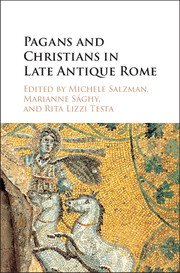 Pagans and Christians in Late Antique Rome
Pagans and Christians in Late Antique Rome Book contents
- Frontmatter
- Contents
- List of Illustrations
- Biographies of Authors
- Acknowledgments
- Introduction
- Part I SENATORIAL POLITICS AND RELIGIOUS CONFLICT
- Part II The Construction of New Religious Identities
- Part III Pagans and Christians: Coexistence and Competition
- Section A Pagans and Religious Practices in Christian Rome
- Section B Death and the Afterlife
- Section C Reading Religious Iconography as Evidence for Pagan–Christian Relations
- Concluding Remarks: Vrbs Roma between Pagans and Christians
- Index
- References
Concluding Remarks: Vrbs Roma between Pagans and Christians
Published online by Cambridge University Press: 05 November 2015
- Frontmatter
- Contents
- List of Illustrations
- Biographies of Authors
- Acknowledgments
- Introduction
- Part I SENATORIAL POLITICS AND RELIGIOUS CONFLICT
- Part II The Construction of New Religious Identities
- Part III Pagans and Christians: Coexistence and Competition
- Section A Pagans and Religious Practices in Christian Rome
- Section B Death and the Afterlife
- Section C Reading Religious Iconography as Evidence for Pagan–Christian Relations
- Concluding Remarks: Vrbs Roma between Pagans and Christians
- Index
- References
Summary
The conference on which this volume is based is a significant contribution – albeit not the last in the view of the editors – to the debate on relations between Christians and pagans, which subject has been recently revived in a series of publications. In 2007, the conflict between pagans and Christians in the fourth century was one of the issues on which the organizers of the International Congress, promoted by the Associazione di Studi Tardoantichi in Naples, invited scholars to make a critical assessment. The following year, in the Monastery of Bose, on the pre-Alps around Biella, where the dialog between religions in the contemporary world is a subject of daily engagement, a new international conference (supported by the Fondazione per le Scienze Religiose Giovanni XXIII in Bologna) gathered scholars of at least three different generations, and from various nations of the world, to discuss this topic. Favoring a historiographical approach, the scholars at this conference traced the directions of historical research since the publication in Oxford in 1963 (and in Turin in 1968) of Arnaldo Momigliano's The Conflict between Paganism and Christianity in the Fourth Century. That book has had an almost paradoxical destiny. As Peter Brown noted as a young listener of the Warburg Lectures and as the first reviewer of the volume's English edition, almost all of its collected essays showed how the Christianization of the empire passed through a process of transformation and transition, rather than competition, struggle, or conflict. In one essay, however, the idea of conflict stood out in a specific way and it was from that essay – which had been conceived more than a decade before – that Momigliano drew inspiration for the title of the volume. He found in Bloch's chapter, which he included as the epilogue to this miscellaneous work, a satisfactory answer to his own view that religious factors were an inseparable part of historical processes, and hence they played a decisive role in the fall of the western empire. Bloch's response was also consistent with the interpretation of the end of Roman paganism that Alföldi had advanced in his interpretation of the contorniates – bronze medallions, produced in Rome from the mid-fourth to the late fifth century, and whose legends were mostly inspired by traditional gods and heroes – as part of a concerted campaign of pagan propaganda sponsored by the aristocracy of Rome.
- Type
- Chapter
- Information
- Pagans and Christians in Late Antique RomeConflict, Competition, and Coexistence in the Fourth Century, pp. 401 - 410Publisher: Cambridge University PressPrint publication year: 2015


